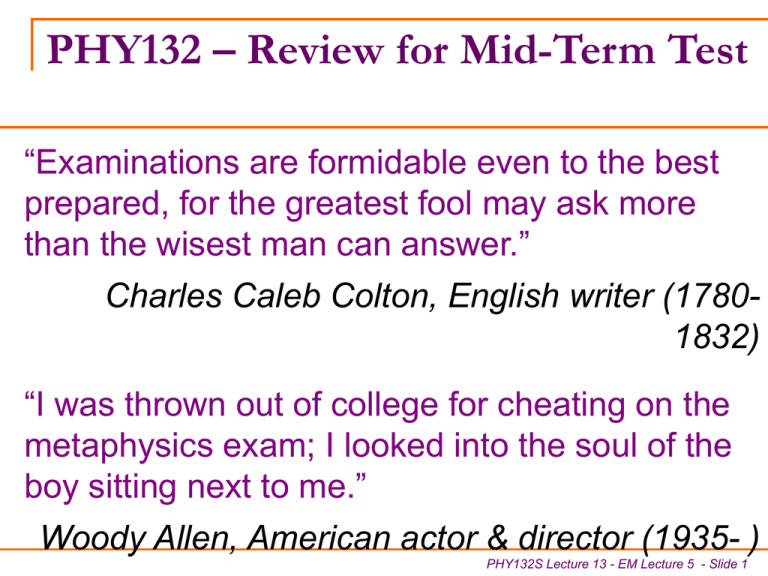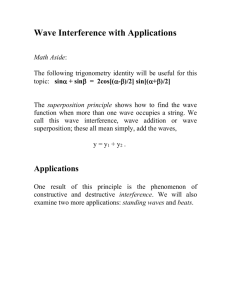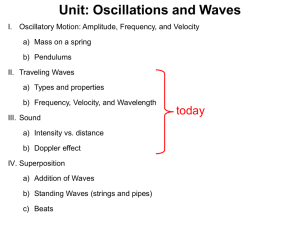PHY132 Mid-Term Test
advertisement

PHY132 – Review for Mid-Term Test “Examinations are formidable even to the best prepared, for the greatest fool may ask more than the wisest man can answer.” Charles Caleb Colton, English writer (17801832) “I was thrown out of college for cheating on the metaphysics exam; I looked into the soul of the boy sitting next to me.” Woody Allen, American actor & director (1935- ) PHY132S Lecture 13 - EM Lecture 5 - Slide 1 PHY132 Mid-Term Test – General Comments 6:10 - 7:30 PM, Tuesday, February 24 It is mandatory that you go to the room assigned to your tutorial group. Test information and room assignments are on the PHY132 home page via the Portal You should have no communication device (phone, pager, etc.) within your reach or field of vision during the test. PHY132S Lecture 13 - EM Lecture 5 - Slide 2 PHY132 Mid-Term Test –Format Format - similar to PHY131 Mid-Term Test 9 equally weighted multiple-choice questions A long-answer section for 37 marks Each question has 4 or 5 possible answers. Each correct answer will be awarded 7 marks. Blank, incorrect, and multiple answers get 0. Two questions: one short, one multi-part Will be graded in detail with part marks awarded as appropriate only if you show your work. The test will be marked out of 100 points. PHY132S Lecture 13 - EM Lecture 5 - Slide 3 PHY132 Mid-Term Test – Don’t Forget ... Your student card. A non-programmable calculator without text storage and communication capability. A single original, handwritten 22 × 28 cm sheet of paper on which you have written anything you wish on both sides. Numerical constants will be provided. One or more dark-black, soft-lead 2B or 2HB pencils and an eraser. PHY132S Lecture 13 - EM Lecture 5 - Slide 4 PHY132 Mid-Term Test – Some Advice A good aid-sheet is well organized, easy to read, and contains all the major equations from the assigned sections from the reading. Copies of detailed specific problem solutions are unlikely to help. Be ready to think; get a good night’s sleep tomorrow night. PHY132S Lecture 13 - EM Lecture 5 - Slide 5 PHY132 Mid-Term Test – Material Covered 1 All material from Lectures 1 through 13 Waves & Oscillations and Electromagnetism This includes All assigned sections from the textbook, whether they were discussed in the lectures or not Lecture notes - sidescreen and tablet All figures and diagrams discussed MasteringPhysics questions Practicals PHY132S Lecture 13 - EM Lecture 5 - Slide 6 PHY132 Mid-Term Test – Material Covered 2 The test includes conceptual and calculation questions The test does NOT include Supplementary material not discussed in class Integration (BUT you should know the integral and derivative relationships that we’ve covered) PHY132S Lecture 13 - EM Lecture 5 - Slide 7 Physics Drop-In Centre Location: MP200, right above main lobby Help desk is in small room at North end of Centre Extended Hours: 10AM - 5PM, Feb. 9-12 and 23-26, closed Reading Week Can just drop in (no need for appointment) Check the schedule at: http://www.physics.utoronto.ca /undergraduate/dic/dic-schedule.htm PHY132S Lecture 13 - EM Lecture 5 - Slide 8 The Waves Section: 8 Classes in 10 Slides The text and our classes often introduced material in a spiral fashion: the various concepts were introduced in pieces. Here I try to make the review of that material more linear. Therefore the review will not always be in the order in which the material was discussed. PHY132S Lecture 13 - EM Lecture 5 - Slide 9 Traveling Waves Two views: • We are at some fixed place and watch the wave go by (history graph) • We view the wave at a fixed time (snapshot graph) For a sinusoidal wave we can combine the two views analytically: D ( x, t ) A sin( kx t 0 ) • Minus sign: wave traveling to the right • Plus sign: wave traveling to the left Mechanical Waves: • Travel through the medium • Wave speed relative to that medium PHY132S Lecture 13 - EM Lecture 5 - Slide 10 Traveling Sinusoidal Waves Source: some sort of Simple Harmonic Motion Source stationary relative to the medium: fwave = fsource f = v (just d / t = v ) • v a property of the medium Source moving relative to the medium: Doppler Effect: fwave fsource All Traveling Waves Power 2 Intensity Amplitude Area PHY132S Lecture 13 - EM Lecture 5 - Slide 11 Reflection (incident wave traveling from left to right) Medium to right has as a smaller wave speed than medium to the left: reflected wave phase shifted by • This includes a “fixed end” Medium to right greater speed than medium to the left: reflected wave not phase shifted • This includes a “free end” PHY132S Lecture 13 - EM Lecture 5 - Slide 12 Superposition Standing Waves: Superposition of incident and reflected waves Interference: Superposition of two waves with equal wavelengths: • Constructive: two waves in phase • Destructive: two waves out of phase by Beats: Superposition of two waves with nearly equal frequencies: • A wave of frequency = the average frequency • Modulated by an amplitude that varies sinusoidally as ½ the difference in the frequencies PHY132S Lecture 13 - EM Lecture 5 - Slide 13 Superposition – more The double slit • Maxima: difference in path length m • Minima: difference in path length (m + ½) Decrease distance d between slits: spread out the interference pattern, and vice versa “Diffraction” Grating: an array of N slits Reflection Grating: an array of N reflecting surfaces Diffraction • Only qualitative • Decrease size of aperture: increase the spread PHY132S Lecture 13 - EM Lecture 5 - Slide 14 Superposition – even more! Interferometers, especially the Michelson Interferometer Refraction Wave Model: sin( 1 ) sin( 2 ) v1 For light: v2 n1 sin(1 ) n2 sin( 2 ) 0 n sin( ) n sin( 90 ) Total Internal Reflection: 1 C 2 PHY132S Lecture 13 - EM Lecture 5 - Slide 15 Ray Model Travel in straight lines Can cross (superposition) Travels until it interacts with matter An object is a source of light rays going in all directions The eye sees by focusing a diverging bundle of rays PHY132S Lecture 13 - EM Lecture 5 - Slide 16 Reflection incident = reflected Plane mirror: forms a virtual image PHY132S Lecture 13 - EM Lecture 5 - Slide 17 Lenses & Curved Mirrors Thins Lens / Thin Mirror Approximation Parallel rays are brought to a focus at the focal point Distance from lens/mirror to the focal point is the focal length f 1 1 1 For both ray tracing gives: f s s' Converging lens / Concave mirror: f > 0 Diverging lens / Convex mirror: f < 0 s’ > 0: real image s’ < 0 : virtual image h' s' Lateral Magnification: m h s PHY132S Lecture 13 - EM Lecture 5 - Slide 18 Multiple Thin Lenses / Thin Mirrors The image of the first is the object for the second Thick Lens The image of the first surface is the object for the second surface Dispersion For some media, wave speed depends on the wave frequency Often we talk about the wavelength instead of the frequency PHY132S Lecture 13 - EM Lecture 5 - Slide 19 PHY132 Mid-Term Test – Electromagnetism Review Chapter 26 - all sections Chapter 27 - §27.1, 27.2, 27.5 in §27.3, we used Equation 27.14 (page 825) in §27.4, we used Equation 27.26 (page 832) Chapter 29 - §29.1, 29.2, 29.3 PHY132S Lecture 13 - EM Lecture 5 - Slide 20 Electric Forces - Coulomb’s Law F1 on 2 Two like charges r q F2 on 1 q1 F1on 2 Opposite charges F1 on 2 q 2 F2 on 1 2 q1 q1 q2 1 q1 q2 F2 on 1 K 2 2 r 4o r F1on 2 F2 on 1 PHY132S Lecture 13 - EM Lecture 5 - Slide 21 Electric Fields The electric field describes the electric force on a test charge at any point in space. Fon q' ( x, y, z) E( x, y, z) q' 1 q , away from q 2 4o r PHY132S Lecture 13 - EM Lecture 5 - Slide 22 Electric Field Lines (for a Dipole) Tangent to field line is in the direction of the electric field at that point. Electric dipole moment: p( x, y, z) qs, from - to PHY132S Lecture 13 - EM Lecture 5 - Slide 23 Parallel Plate Capacitor - Uniform Electric Field & Potential Energy Q E capacitor , o o A from to plate Uelec Welec (i f ) qE s Uelec Uo qEs PHY132S Lecture 13 - EM Lecture 5 - Slide 24 Electric Potential Energy of a System of Two Point Charges Uelec 1 q1q2 4o r PHY132S Lecture 13 - EM Lecture 5 - Slide 25 Good Luck! PHY132S Lecture 13 - EM Lecture 5 - Slide 26







